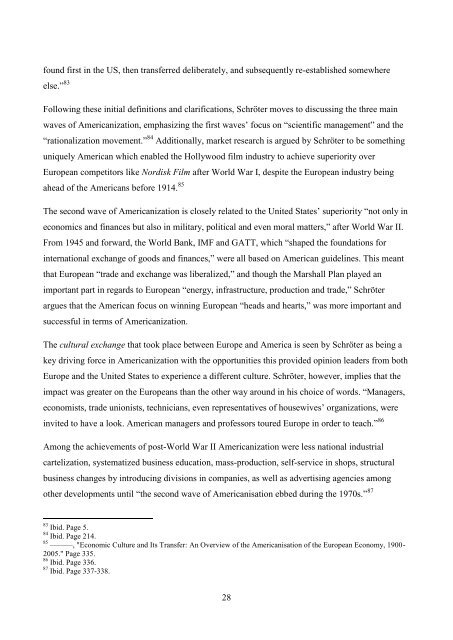The Jeremiad Over Journalism
The Jeremiad Over Journalism
The Jeremiad Over Journalism
You also want an ePaper? Increase the reach of your titles
YUMPU automatically turns print PDFs into web optimized ePapers that Google loves.
found first in the US, then transferred deliberately, and subsequently re-established somewhere<br />
else.‖ 83<br />
Following these initial definitions and clarifications, Schröter moves to discussing the three main<br />
waves of Americanization, emphasizing the first waves‘ focus on ―scientific management‖ and the<br />
―rationalization movement.‖ 84 Additionally, market research is argued by Schröter to be something<br />
uniquely American which enabled the Hollywood film industry to achieve superiority over<br />
European competitors like Nordisk Film after World War I, despite the European industry being<br />
ahead of the Americans before 1914. 85<br />
<strong>The</strong> second wave of Americanization is closely related to the United States‘ superiority ―not only in<br />
economics and finances but also in military, political and even moral matters,‖ after World War II.<br />
From 1945 and forward, the World Bank, IMF and GATT, which ―shaped the foundations for<br />
international exchange of goods and finances,‖ were all based on American guidelines. This meant<br />
that European ―trade and exchange was liberalized,‖ and though the Marshall Plan played an<br />
important part in regards to European ―energy, infrastructure, production and trade,‖ Schröter<br />
argues that the American focus on winning European ―heads and hearts,‖ was more important and<br />
successful in terms of Americanization.<br />
<strong>The</strong> cultural exchange that took place between Europe and America is seen by Schröter as being a<br />
key driving force in Americanization with the opportunities this provided opinion leaders from both<br />
Europe and the United States to experience a different culture. Schröter, however, implies that the<br />
impact was greater on the Europeans than the other way around in his choice of words. ―Managers,<br />
economists, trade unionists, technicians, even representatives of housewives‘ organizations, were<br />
invited to have a look. American managers and professors toured Europe in order to teach.‖ 86<br />
Among the achievements of post-World War II Americanization were less national industrial<br />
cartelization, systematized business education, mass-production, self-service in shops, structural<br />
business changes by introducing divisions in companies, as well as advertising agencies among<br />
other developments until ―the second wave of Americanisation ebbed during the 1970s.‖ 87<br />
83 Ibid. Page 5.<br />
84 Ibid. Page 214.<br />
85 ———, "Economic Culture and Its Transfer: An <strong>Over</strong>view of the Americanisation of the European Economy, 1900-<br />
2005." Page 335.<br />
86 Ibid. Page 336.<br />
87 Ibid. Page 337-338.<br />
28
















